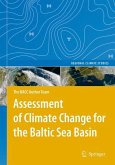This book describes thoroughly the North American Climate of the past 65 million years, with special emphasis on the last 21,000 years, as revealed by paleoclimatic observations and climate models. It analyzes weather observations over the past century and satellite measurements of the last few decades to develop a picture of more recent climatic trends. It explains how global climate models are used to simulate and project climate, and presents the application of these models to reproduce recent climate variations and predict future North American climate. It answers the critical question of whether observed climate change is due to natural variations or human activity.
"Climate Change in North America presents a comprehensive review of the past, present, and future climate over the continent of North America. ... The book goes beyond a simple documentation of climate change to educating the reader with state-of-the-art data sets and statistical methods. ... Overall, the book is highly readable and provides an excellent resource for the general reader, as well as students and scholars of climate change." (Matt Christensen, Space Research Today, Issue 194, December, 2015)
"Climate Change in North America covers, in a deeper sense, resources and methods utilized in climate research. ... Figures and presentation of all the chapters are clean and well illustrated. ... This book will appeal to researchers studying climate change impacts and responses; it would also make a nice textbook for upper-level undergraduatestudents and entry-level graduate students interested in climate change-related studies. I recommend it." (S.-Y. Simon Wang, Bulletin of the American Meteorological Society, October, 2015)
"This comprehensive, accessible work discusses climate change on the continental scale, probably the smallest spatial scale for which future predictions of climate conditions are even modestly reliable. ... The well-written informative work will be useful to readers interested in the continental implications of climate change. ... Summing Up: Recommended. Lower-division undergraduates and above." (T. N. Chase, Choice, Vol. 52 (3), November, 2014)
"The introduction says this book is aimed at policy makers, students of climate change and climate scientists. Policy makers may well limit themselves to the introduction and summaries at the end of each chapter. However, time spent on the rest of the book will amply repay anyone who wants to understand the present state of climate science." (Dan Tarpley, Amazon.com, May, 2014)
"This is a professional, cautious, sobering book about a contentious subject. ... the authors are quite careful in pointing out which results are statistically reliable and which need a longer record to inspire more confidence. ... the authors are also very careful about stating which aspects of future North American climate change have a strong consensus and which don't. This is a refreshing trend for a subject in which much hot air and ink has been spilled on conflicting claims." (Jerry Sullivan, Amazon.com, May, 2014)
"Climate Change in North America covers, in a deeper sense, resources and methods utilized in climate research. ... Figures and presentation of all the chapters are clean and well illustrated. ... This book will appeal to researchers studying climate change impacts and responses; it would also make a nice textbook for upper-level undergraduatestudents and entry-level graduate students interested in climate change-related studies. I recommend it." (S.-Y. Simon Wang, Bulletin of the American Meteorological Society, October, 2015)
"This comprehensive, accessible work discusses climate change on the continental scale, probably the smallest spatial scale for which future predictions of climate conditions are even modestly reliable. ... The well-written informative work will be useful to readers interested in the continental implications of climate change. ... Summing Up: Recommended. Lower-division undergraduates and above." (T. N. Chase, Choice, Vol. 52 (3), November, 2014)
"The introduction says this book is aimed at policy makers, students of climate change and climate scientists. Policy makers may well limit themselves to the introduction and summaries at the end of each chapter. However, time spent on the rest of the book will amply repay anyone who wants to understand the present state of climate science." (Dan Tarpley, Amazon.com, May, 2014)
"This is a professional, cautious, sobering book about a contentious subject. ... the authors are quite careful in pointing out which results are statistically reliable and which need a longer record to inspire more confidence. ... the authors are also very careful about stating which aspects of future North American climate change have a strong consensus and which don't. This is a refreshing trend for a subject in which much hot air and ink has been spilled on conflicting claims." (Jerry Sullivan, Amazon.com, May, 2014)



